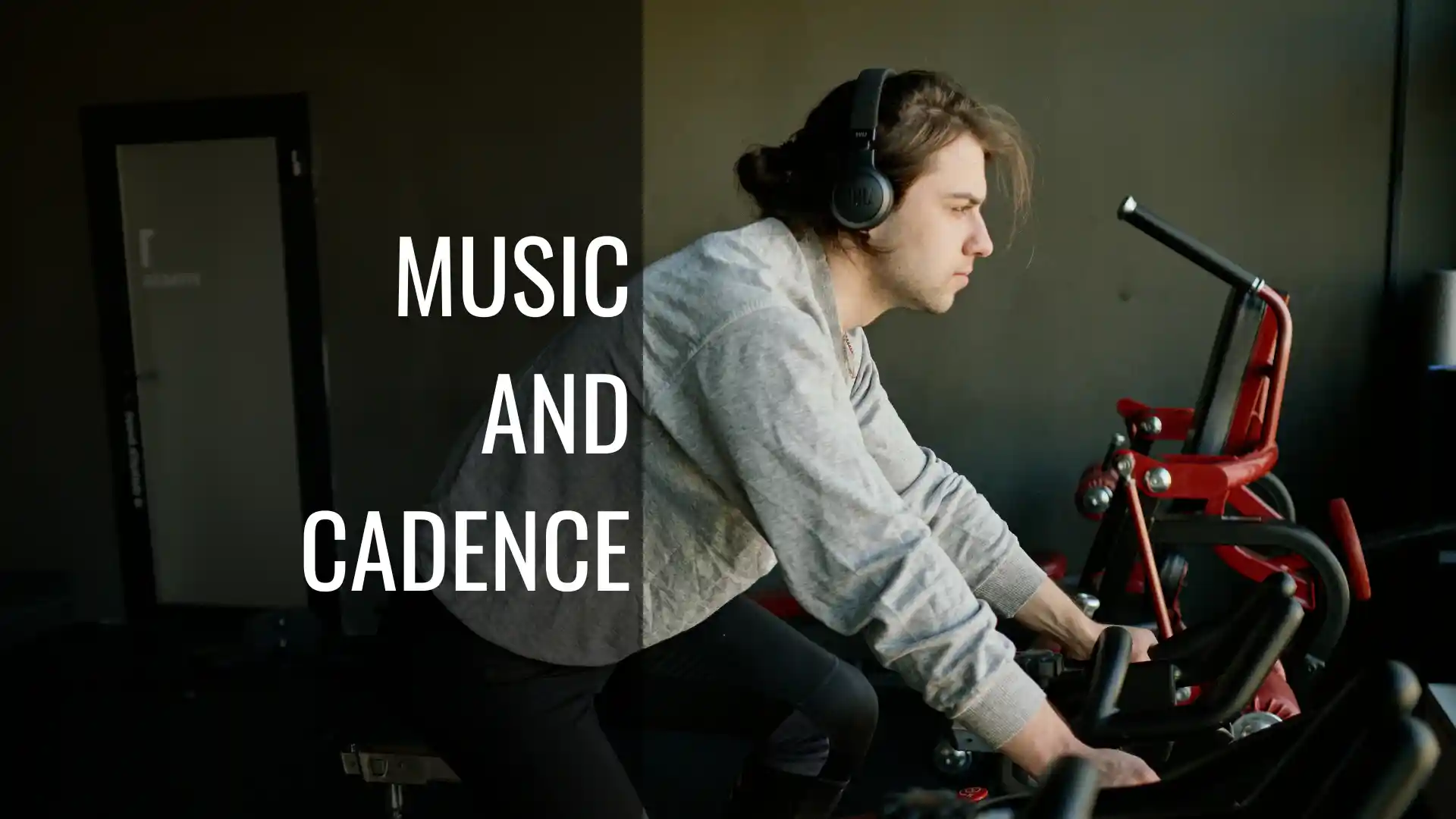
The connection between music and cycling cadence is not obvious. But every indoor cyclist knows the feeling: you’re grinding through a monotonous trainer session when the right song comes on, and suddenly your legs find a rhythm you didn’t know you had. This isn’t just motivation—it’s neuroscience in action. Music tempo doesn’t simply distract you from the effort of pedaling; it fundamentally alters how your brain coordinates movement, creating what researchers call auditory-motor synchronization.
While many of us intuitively know that pedaling in sync with music helps maintain a steady rhythm, its scientific underpinnings and broader benefits are worth a deep dive. Join us as we explore how music tempo rewires cadence consistency on indoor rides, backed by scientific studies and practical tips.
PEDAL MY WAY NEWSLETTER
Weekly training tips, cycling strategies, and fitness insights for sustainable performance.
No spam—just actionable guidance to help you train smarter.
Table of Contents
The Science of Auditory-Motor Synchronization
Auditory-motor synchronization is the brain’s remarkable ability to coordinate physical movements with rhythmic auditory cues, and plays a crucial role in cycling performance. This process involves several neural pathways, primarily connecting the auditory cortex to motor planning regions like the premotor cortex and supplementary motor area. When you listen to music, especially one with a steady beat, your brain automatically begins predicting when the next beat will occur, allowing your motor system to time movements accordingly.
What makes this particularly powerful for cycling is that the synchronization happens largely unconsciously. The auditory cortex processes the sound, transmitting it to the basal ganglia and cerebellum, which then regulate movement, timing, and coordination. The central nervous system uses the music’s temporal structure as an external pacemaker, reducing the cognitive load required to maintain consistent cadence. The result is our body synchronizing its movements, such as cycling cadence, with the rhythm of the music.
Neuroimaging studies have shown that when people synchronize movements to music, there’s increased connectivity between auditory and motor regions, essentially creating a more efficient neural circuit for repetitive motion.
The phenomenon extends beyond simple beat-matching. Your brain also responds to the music’s intensity, melodic structure, and emotional content, all of which can influence motor output. This multi-layered neural engagement explains why music doesn’t just help you maintain rhythm—it can make sustained effort feel more automatic and less mentally taxing.
Music Tempo vs. Cadence: What Studies Show
Several studies support the strong correlation between music tempo and cycling cadence. Researchers found that participants synced their pedaling with a song’s beat, even when not instructed to do so. When researchers manipulated music tempo during cycling sessions, participants’ cadence shifted accordingly—faster music led to faster pedaling, and slower music reduced cadence.
One particularly compelling study found that when cyclists listened to music with tempos matching their target cadence, they maintained that cadence with significantly less variability compared to riding in silence or with non-matched music. The effect was most pronounced in the 80-100 RPM range, which aligns with typical endurance cycling cadences. Interestingly, the synchronization effect becomes stronger as exercise intensity increases, suggesting that music’s regulatory influence on movement may be most valuable when fatigue begins to compromise technique.
The research also reveals individual differences. Experienced cyclists show stronger auditory-motor coupling than novices, likely because their more automated pedaling technique allows easier integration with external rhythms. However, even beginners benefit from tempo-matched music, particularly in reducing cadence fluctuations during longer efforts. Additionally, music with motivational qualities was shown to enhance the perceived exertion rate, making workouts more enjoyable and sustainable.
How Cyclists Naturally Sync Their Pedaling to Music
Cyclists often instinctively adjust their cadence to match the tempo of their chosen music. This phenomenon, known as entrainment, happens subconsciously and can greatly influence one’s perception of effort, pain, and motivation during an indoor cycling session. This synchronization happens through several mechanisms, many of which operate below conscious awareness. Most fundamentally, cyclists tend to align their pedal strokes with the beat—either matching one full revolution to each beat or, more commonly with faster music, matching each downstroke (one per leg) to alternating beats.
This synchronization isn’t rigid. Your brain engages in what researchers call “phase correction,” constantly making micro-adjustments to keep your movements aligned with the rhythm. If your pedal stroke drifts out of sync, your nervous system automatically speeds up or slows down slightly to recapture the beat. This continuous adjustment actually helps maintain more consistent cadence than riding without musical cues.
The type of music matters significantly. Songs with prominent, percussive beats (like electronic music, hip-hop, or rock with strong drum lines) provide clearer temporal anchors than music with ambiguous rhythms. Your brain latches onto these salient beats, using them as reference points for timing each pedal revolution. Additionally, music with consistent tempo throughout the song supports better synchronization than tracks with varying speeds or extended instrumental breaks.
Interestingly, many cyclists report that they “feel” their pedaling become smoother when the right song comes on. This perception reflects an actual physiological reality—EMG studies show that muscle activation patterns become more regular and coordinated when movements are synchronized to music.
Psychological and Physiological Benefits of Cycling to Music
Cycling to music offers numerous psychological and physiological benefits that translate into better indoor cycling performance. These include increased motivation, improved mood, better rhythm synchronization, enhanced performance, and perceived exertion rate. Music also serves as a dissociative strategy, directing attention away from fatigue signals and physical discomfort. During submaximal efforts, this attentional shift can reduce ratings of perceived exertion by 10-15%, allowing you to sustain efforts longer or at higher intensity with the same subjective difficulty.
Music also triggers emotional and motivational responses. Upbeat, energizing music stimulates the release of dopamine and can increase arousal levels, preparing your nervous system for physical effort. This pre-activation effect can improve power output at the start of intervals and help you push through challenging segments. Many cyclists report that specific songs or playlists become psychologically linked with strong performances, creating a conditioned motivational response. Additionally, listening to music during workouts has been linked to reduced stress and anxiety, as well as heightened focus and endurance.
Physiologically, tempo-matched music can improve movement economy. When your pedaling syncs with musical rhythm, there’s evidence of reduced unnecessary muscle co-contractions and more efficient force application through the pedal stroke. This mechanical efficiency means you’re burning slightly less energy for the same power output—a small advantage that compounds over long training sessions.
The consistency benefits also have injury prevention implications. Erratic cadence and irregular pedaling mechanics can contribute to overuse injuries over time. By promoting steadier rhythm and smoother technique, music may reduce these biomechanical stress patterns.
Practical Tips for Using Music to Improve Your Indoor Cadence
To harness the power of music for your indoor rides, start by curating a playlist that matches your workout goals and preferred cycling cadence. Experiment with different genres, artists, and songs until you find tracks that help you achieve your desired rhythm. Furthermore, invest in quality headphones or speakers to ensure an immersive auditory experience.
For steady-state endurance work, most cyclists target 85-95 RPM, while tempo efforts might be 90-100 RPM, and high-intensity intervals could push 100-110 RPM or higher. Create playlists with BPM ranges that match these targets.
A useful formula: if you want to match one pedal revolution to one beat, use music at your target RPM. For example, 90 RPM cadence pairs with 90 BPM music. However, many cyclists find it more natural to match each leg’s downstroke to alternating beats, which means doubling the music tempo—so 180 BPM music for a 90 RPM cadence target. Experiment to find which approach works intuitively for you.
Use BPM-detection tools or apps like Spotify’s tempo filters, Apple Music’s BPM playlists, or dedicated services like jog.fm to build tempo-specific playlists. Many streaming platforms now offer curated workout playlists organized by BPM. For structured workouts with varying intervals, create segmented playlists that shift tempo to match each interval’s cadence target, or use apps that automatically adjust music speed without changing pitch.
Place speakers or use headphones that allow you to clearly hear the beat over trainer noise. The more distinct the rhythm, the stronger the synchronization effect. If you’re using smart trainers with apps like Zwift or TrainerRoad, some platforms allow playlist integration that can even auto-match music tempo to your programmed intervals.
Start workouts with warm-up music at your easy spinning cadence, then transition to workout-appropriate tempos. This progressive approach helps your neuromuscular system gradually entrain to the rhythmic cues rather than forcing sudden shifts.
Risks & Considerations
While music offers substantial benefits, there are scenarios where it may be counterproductive. During workouts specifically designed to develop cadence control and neuromuscular awareness, music can become a crutch that masks technical deficiencies. Periodically training without music helps develop intrinsic rhythm sense and better proprioceptive awareness of your pedaling mechanics.
For high-intensity sprint intervals or standing climbs, very fast music might encourage unnaturally high cadences that compromise power output and technique. Not all efforts benefit from high cadence—sometimes grinding at lower RPMs with higher force is the appropriate training stimulus. Let your workout’s goals dictate whether musical tempo matching is suitable.
There’s also risk of over-reliance leading to poor pacing judgment. If you always depend on music to regulate effort, you may struggle to maintain consistency during outdoor rides or events where music isn’t available or practical. Balance music-assisted training with sessions focused on internal pacing cues and perceived exertion.
Be mindful of hearing health, especially during long trainer sessions with high-volume music. Prolonged exposure to loud music through headphones can contribute to hearing damage over time. Keep volumes at reasonable levels and consider speakers rather than headphones for extended sessions.
Finally, music’s dissociative effects, while beneficial for endurance, might cause you to ignore important warning signs of overtraining or injury. Always maintain awareness of acute pain, unusual fatigue, or other signals that warrant backing off, regardless of how motivated the music makes you feel.
Tailoring Your Music Strategy by Training Goal
Your music strategy should align with your cycling objectives. Different training objectives call for different musical approaches.
For endurance base-building sessions, prioritize consistency over intensity. Choose music with steady, moderate tempos (85-95 BPM or 170-190 BPM) that matches your aerobic cadence. The goal is sustainable rhythm over long durations, so select tracks that maintain consistent tempo throughout and avoid songs with dramatic tempo shifts or extended breaks.
For high-intensity interval training (HIIT), opt for fast-paced songs that promote quick pedal strokes. In contrast, during endurance rides, choose music with a steady beat that encourages consistent, sustained efforts.
Sweet spot and tempo workouts benefit from slightly more energetic music that sustains motivation through sustained moderate-high intensity. Music in the 90-100 BPM range (or 180-200 BPM for alternating downstroke matching) works well. These sessions are long enough that dissociative benefits help, but intense enough that tempo matching supports technique under fatigue.
For VO2max intervals and threshold work, where you’re pushing near maximal sustainable efforts, highly motivating music with driving rhythms can provide crucial psychological support. However, be cautious about forcing cadence matching during these efforts—let power output and technique take priority, using music more for motivation than strict tempo guidance.
Sprint intervals and neuromuscular training often work best with high-energy music for motivation, but avoid letting music dictate cadence here. These efforts are about maximal power production at whatever cadence naturally produces your highest watts, which varies individually and by sprint type.
Recovery rides may benefit from calmer music at easy spinning cadences (80-85 BPM range), though some cyclists prefer podcasts or no audio at all for these sessions. The key is avoiding any tempo that encourages pushing harder than recovery effort requires.
For race preparation or specific event simulation, gradually reduce music dependence in favor of developing internal pacing skills. If you’ll race without music, train that way regularly to ensure the skill transfers.
Finding Your Rhythm
The relationship between music tempo and cadence consistency isn’t just about entertainment—it’s a scientifically grounded training tool that can make your indoor rides more effective and enjoyable. By understanding how auditory-motor synchronization works and strategically matching your playlists to your training goals, you can leverage your brain’s natural tendency to entrain movement to rhythm. Start by experimenting with tempo-matched music during your next few indoor sessions, paying attention to how different BPM ranges affect your pedal stroke smoothness and perceived effort.
Remember that music is most powerful when used intentionally rather than automatically—some workouts benefit from its rhythmic guidance, while others require the focus that comes from silence. The best indoor cyclists develop both skills: the ability to lock into an external beat when it serves their goals, and the capacity to generate consistent cadence from internal awareness alone. As you build your tempo-specific playlists and refine your musical strategy, you’ll likely discover that the right soundtrack doesn’t just make the time pass faster—it rewires how efficiently and consistently your legs turn the pedals, transforming every indoor session into a more precise, productive training stimulus.
Related Cycling and Training Content
For further cycling and training tips, you can also listen to the Ask The Pedalist podcast, where we discuss common cycling topics.
Sources for Research
Here are some key sources that would support the claims made in this blog post:
Auditory-Motor Synchronization & Neuroscience
- Zatorre, R. J., Chen, J. L., & Penhune, V. B. (2007). “When the brain plays music: auditory-motor interactions in music perception and production.” Nature Reviews Neuroscience, 8(7), 547-558.
- Chen, J. L., Penhune, V. B., & Zatorre, R. J. (2008). “Listening to musical rhythms recruits motor regions of the brain.” Cerebral Cortex, 18(12), 2844-2854.
- Repp, B. H., & Su, Y. H. (2013). “Sensorimotor synchronization: A review of recent research (2006-2012).” Psychonomic Bulletin & Review, 20(3), 403-452.
Music Tempo Effects on Cycling Performance
- Karageorghis, C. I., & Priest, D. L. (2012). “Music in the exercise domain: A review and synthesis (Part I).” International Review of Sport and Exercise Psychology, 5(1), 44-66.
- Bacon, C. J., Myers, T. R., & Karageorghis, C. I. (2012). “Effect of music-movement synchrony on exercise oxygen consumption.” Journal of Sports Medicine and Physical Fitness, 52(4), 359-365.
- Waterhouse, J., Hudson, P., & Edwards, B. (2010). “Effects of music tempo upon submaximal cycling performance.” Scandinavian Journal of Medicine & Science in Sports, 20(4), 662-669.
Psychological & Physiological Benefits
- Terry, P. C., Karageorghis, C. I., Saha, A. M., & D’Auria, S. (2012). “Effects of synchronous music on treadmill running among elite triathletes.” Journal of Science and Medicine in Sport, 15(1), 52-57.
- Hutchinson, J. C., & Karageorghis, C. I. (2013). “Moderating influence of dominant attentional style and exercise intensity on psychological and psychophysical responses to asynchronous music.” Journal of Sport and Exercise Psychology, 35(6), 625-643.
- Bigliassi, M., et al. (2015). “It’s not just the music: Psychophysiological responses are also influenced by music’s structure and contextual cues.” Psychology of Sport and Exercise, 19, 75-83.
Movement Economy & Biomechanics
- Leman, M., et al. (2013). “Activating and relaxing music entrains the speed of beat synchronized walking.” PLoS ONE, 8(7), e67932.
- Van Dyck, E., et al. (2015). “Spontaneous entrainment of running cadence to music tempo.” Sports Medicine – Open, 1(1), 15.
Additional Reading
- Karageorghis, C. I. (2016). “The scientific application of music in sport and exercise.” In Sport and Exercise Psychology (pp. 109-133). Routledge.
- Jones, L., Karageorghis, C. I., & Ekkekakis, P. (2014). “Can high-intensity exercise be more pleasant? Attentional dissociation using music and video.” Journal of Sport and Exercise Psychology, 36(5), 528-541.





